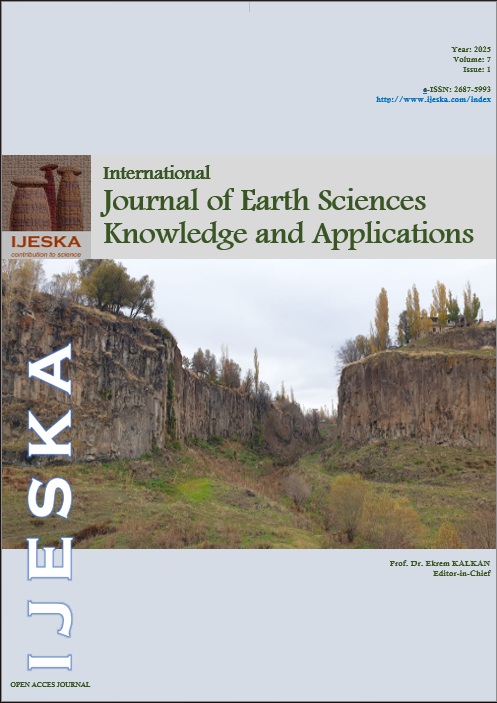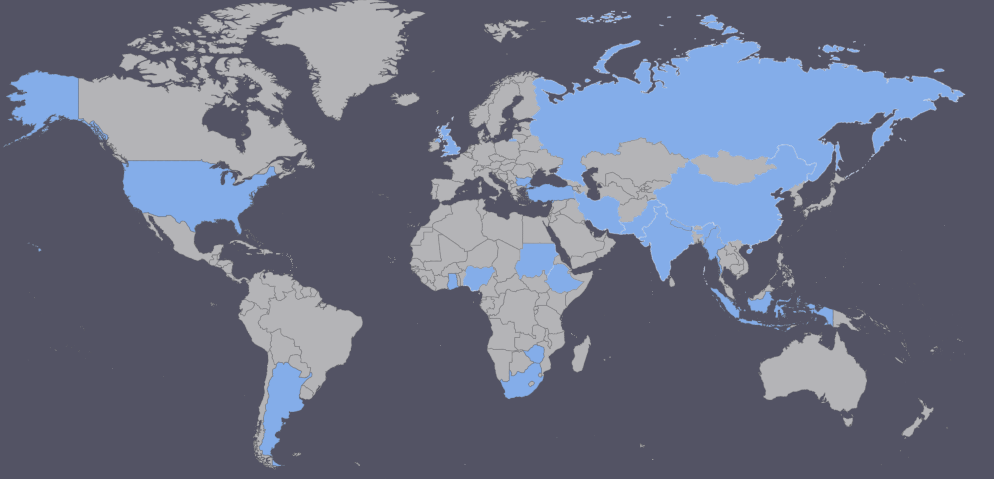Petrographical and Geochemical Studies on the Granitic Rocks Around Igarra-Ugbogbo Area, Southwestern Nigeria
Keywords:
granitoids, geochemical, minerals, alumina, magmaAbstract
Seven samples of granitic rocks from Igarra-Ugbogbo area in Akoko-Edo Local Government Area of Southwestern Nigeria were obtained with the aim of determining their geochemical and mineralogical properties using XRF, XRD techniques and thin section. Thin section results revealed the optical properties of the minerals present and their behaviours to light. The photomicrographs reveal the presence of various minerals such as quartz, microcline, plagioclase, muscovite and biotite. Results of the geochemical analysis revealed the presence of SiO2 (56.99-71.22wt.%), Al2O3 (13.55-20.76wt.%), Fe2O3(T)* (3.55-5.85wt.%), K2O (0.95-7.21wt.%), Na2O (2.82-3.98wt.%), CaO (1.88-3.03wt.%) and MgO (0.50-1.56wt.%). The abundance of these major oxides in the samples showed that samples UGB 02, UGB 03, UGB 04, UGB 05 and UGB 07 are probably from a felsic magma and UGB 01 and UGB 06 from an intermediate magma. Using Al2O3 classification schemes, its showed that the samples fall into the metaluminous and peraluminous field. The XrD analysis revealed the presence of quartz, alkali feldspars (microcline, orthoclase and sanidine), plagioclase feldspars (albite and anorthite), muscovite, lepidolite, petalite, amblygonite and illite. The modal composition of the quartz, alkali feldspar, plagioclase was plotted on a QAP diagram which showed that the rock falls within the granitoidal class (granite and granodiorite). The trace element plot of Rb versus (Y+Nb) reveal their tectonic setting to be from post-collision to within-plate granitoids.
References
Ajibade, A.C., Woakes, M. and Rahaman, M.A. (1987): Proterozoic Crustal Development in the Pan-African Regime of Nigeria. Proterozoic Lithospheric Evolution 17, pp. 259-271.
Akinola, O. O., Ghani, A. A. and James, E. (2021). Petrography and Geochemical Characterization of Granite Batholith in Idanre, Southwestern Nigeria. Sains Malaysiana 50(2), pp.315-326.
Bowen, N. L. (1928). The Evolution of Igneous Rocks. Princeton University Press, Princeton.
Chappell, B. W. and White, A. J. R. ( 1992). I-and-S-type Granites in the Lachlan Fold Belt. Earth and Environmental Science Transaction of the Royal Society of Edinburgh 83(1-2), pp. 1-26. pp.29-44.
Falconer, J. D. (1911). The Geology and Geography of the Northern Nigeria. Macmillan, London pp.135.
Isibor, R. A and Aderogbin, J. A. (2020): Petrography and Geochemistry of granitoid Rocks Around Fiditi Area, Nigeria: Implications for their Petrogenesis and Tectonic Setting. International Journal of Innovative Research and Advanced Studies 7(4), pp. 89-100.
Kroner, A., Ekwueme, B. N. and Pidgeon, R. T. (2001): The oldest rock in West Africa: SHRIMP zircon age for Early Archaean Migmatitic Orthogneiss at Kaduna, Northern Nigeria. The Journal of Geology, 109, 399 – 406
Myers, J. S. (1997): Geology of granites. Journal of the Royal Society of Western Australia, 80 (3), pp. 87 - 100.
Obiefuna, G. I., Sini, P. H. and Abubakar, M. (2018): Geochemical and Mineralogical Composition of Granitic Rock Deposit of Michika Area, Northeast, Nigeria. International Journal of Scientific and Technology Research (4), pp.160-170.
Odeyemi, I. B. (1976): Preliminary report on the relationships of Basement Complex Rocks around Igarra, Mid-Western State, Nigeria. Geology of Nigeria, University of Ife, Nigeria.
Odeyemi, I. B. (1988): Lithostratigraphy and Structural Relationships of the Upper Precambrian Metasediments in Igarra Area, Southwestern Nigeria. Precambrian Geology of Nigeria, Geological Survey of Nigeria, pp.111- 122.
Odokuma-Alonge, O., Egwuatu, P. N. and Okunuwadje, S. E. (2019): Geochemical Consideration of some Granitoids around Ojirami-Ogbo and Environs, Southwestern, Nigeria. Journal Applied Science and Environmental Management 23(6), pp.1127-1131.
Okonkwo, C. T. and Folorunso, I. O. (2013): Petrochemistry and Geotectonic Setting of Granitic Rocks in Aderan Area, Southwestern Nigeria. Canadian Center of Science and Education 5(1).
Olayinka, O. A. and Kunle, A. S. (2023): Radiological and Geochemical Assessment of Different Rock Types in Ogun State in Southwestern Nigeria. Journal of Environmental Health Science 48(5), pp. 251-261
Omanayin, Y. A., Abubakar, J. andOwuri, A. S. (2022): Petrography and Geochemical Classificaton of the Saigbe Granites,Northcentral, Nigeria. Ilorin Journal of Science 9(2), pp. 62-180.
Oyawoye, M. O. (1964): The Geology on Nigerian Basement Complex: A survey of our Present Knowledge of them. Journal of Nigerian Mining, Geological and Metallurgical Society 1(2), pp. 87-102.
Pearce, J. A., Harris, N. B. W. and Tindle, A. G. (1984). Trace Element Discrimination Diagrams for the Tectonic Interpretation of Granitic Rocks. Journal of Petrology 25(4), pp. 956-963.
Rahaman, M. A. (1976). Review of the Basement geology of Southwestern Nigeria, Geology of Nigeria (Edited by Kogbe, C. A.), Elizabethan Publishers Lagos. pp.41-58.
Rahaman, M. A. (1988). Recent advances in the study of the Basement Complex of Nigeria, Precambrian Geology of Nigeria, Geological Survey of Nigeria pp. 11-43.
Rowland E. O. (1953): Rapid method for preparation of thin rock sections. Mineral Magazine 30,
254 - 258.
Sambo G. N, Adegbe M. and Onimisi E. A. (2020): Petrochemistry of granitic rocks in Gwada, North Central Nigeria. International Journal of Scientific Research in Multidisciplinary Studies, 6(3), 32 – 38.
Streckeisen, A. (1976). To each Plutonic Rock its proper name, Earth-Science Reviews,12(1),pp. 1-33.
Truswell, J. F. and Cope, R. N. (1963): The geology of parts of Niger and Zaria provinces, Northern Nigeria, Geological Survey of Nigeria Bulletin, 29, 17 - 22.
White, A. J. R. and Chappell, B. W. (1977): I- and S-type granites in the Lachlan Fold Belt. Transactions of the Royal Society of Edinburgh, Earth Sciences, 83, 1–26
Downloads
Published
Issue
Section
License
Copyright (c) 2025 Dr(Mrs). Ovie Odokuma-Alonge, Rita G. Akro

This work is licensed under a Creative Commons Attribution-NonCommercial-NoDerivatives 4.0 International License.
The authors keep the copyrights of the published materials with them, but the authors are aggee to give an exclusive license to the publisher that transfers all publishing and commercial exploitation rights to the publisher. The puslisher then shares the content published in this journal under CC BY-NC-ND license.



